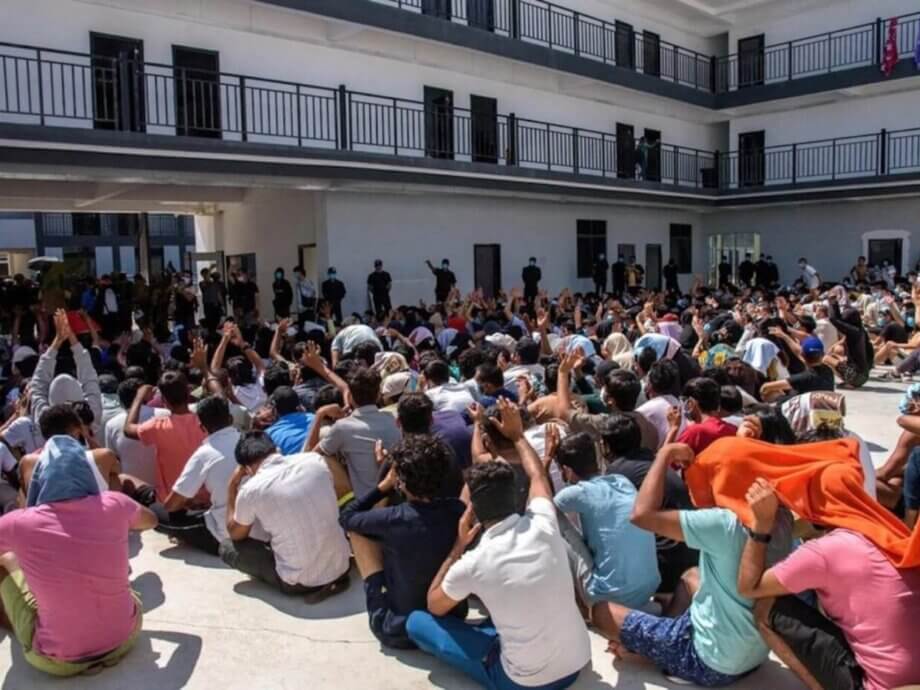The Rise of AI-Driven Human Trafficking Scam Centers
In the digital age, a new and deeply troubling form of organized crime has emerged: online scam centers powered by human trafficking and advanced technologies like artificial intelligence (AI). Once concentrated in Southeast Asia, these criminal enterprises have rapidly expanded their reach, now affecting at least 66 countries across every continent. The International Criminal Police Organization (Interpol), the United Nations Office on Drugs and Crime (UNODC), and numerous investigative reports warn that these scam centers represent a global crisis—one that exploits both the vulnerable individuals forced to perpetrate fraud and the millions of victims deceived online.
- The Rise of AI-Driven Human Trafficking Scam Centers
- How Scam Centers Operate: From Recruitment to Exploitation
- The Double-Edged Threat: Two Sets of Victims
- AI and Deepfakes: The New Tools of the Trade
- Global Expansion: From Southeast Asia to the World
- Criminal Diversification: More Than Just Scams
- Who Are the Traffickers?
- The Human Toll: Stories from Inside the Scam Centers
- Financial Scale and Economic Impact
- Law Enforcement and International Response
- Broader Implications: A New Era of Organized Crime
- What Can Be Done? The Path Forward
- In Summary
How Scam Centers Operate: From Recruitment to Exploitation
At the heart of this criminal ecosystem are scam centers—often referred to as “fraud factories”—where trafficked individuals are forced to carry out online scams. The process typically begins with fake job advertisements, many now generated or enhanced by AI, promising lucrative positions in marketing, IT, or customer service. Unsuspecting job seekers, sometimes from halfway across the world, are lured to compounds in countries like Myanmar, Cambodia, Laos, and the Philippines. Upon arrival, their identification documents are confiscated, and they are detained under threat of violence, debt bondage, or even torture.
Inside these compounds, victims are trained to run a variety of online scams, including:
- Investment frauds (often involving cryptocurrency)
- Romance scams (also known as “pig butchering” or “romance baiting”)
- Online gambling frauds
- Money transfer and phishing schemes
Those who resist or fail to meet quotas face brutal punishments, including beatings, electric shocks, or threats to sell their organs. Some are only released after their families pay ransoms or recruit replacements. The psychological toll is immense, with many victims suffering long-term trauma even after rescue.
The Double-Edged Threat: Two Sets of Victims
Interpol and UNODC describe these scam centers as a “double-edged threat.” On one side are the trafficked individuals, coerced into criminal activity under duress. On the other are the global victims—ordinary people deceived into sending money, investing in fake opportunities, or sharing sensitive information. The financial and emotional damage is staggering: billions of dollars are lost each year, and countless lives are upended.
According to Chainalysis, a blockchain research firm, crypto wallets linked to scams received nearly $10 billion in cryptocurrency in 2024 alone, with projections suggesting this figure could rise to $12.4 billion as more scam wallets are identified. The prevalence of romance scams, in particular, has surged, with “pig butchering” schemes growing by nearly 40% year over year and the number of victims expanding rapidly.
AI and Deepfakes: The New Tools of the Trade
What sets the current wave of scam centers apart from earlier forms of cybercrime is the integration of advanced technologies. AI is now used to:
- Generate highly convincing fake job advertisements
- Create deepfake images, videos, and profiles for romance and sextortion scams
- Automate social engineering scripts, making scams more scalable and harder to detect
John Wojcik, a regional analyst at the UNODC, explains:
“Criminal groups once limited by lack of expertise are now empowered to run highly technical scams with minimal knowledge, thanks to AI.”
Deepfake technology, in particular, has made it nearly impossible for targets to distinguish between real and fake identities. Scammers can now impersonate real people, bypass identity verification controls, and build trust with victims at unprecedented speed. The UNODC reports a 600% increase in mentions of deepfakes in scam activity by early 2024, with some countries seeing surges above 2,500% in just one year.
Global Expansion: From Southeast Asia to the World
While Southeast Asia remains the epicenter—74% of known trafficking victims are taken to scam centers in the region—the model has spread rapidly. Crackdowns in countries like Cambodia and Myanmar have pushed syndicates to seek new havens in West Africa, the Middle East, Central America, and even parts of Europe and North America. The UN likens this spread to a cancer: when authorities disrupt operations in one area, the criminal networks simply migrate and reestablish themselves elsewhere, often in regions with weak governance or limited law enforcement capacity.
Recent high-profile cases illustrate the global reach:
- In Namibia, a scam center was dismantled in 2024, freeing 88 young people and leading to the seizure of hundreds of computers and mobile phones.
- In Nigeria, nearly 1,000 people were arrested in raids on facilities used for romance scams targeting victims in Europe and the Americas.
- In Myanmar’s KK Park, thousands of trafficked workers have been rescued, but up to 100,000 are believed to remain enslaved in scam compounds.
These operations are often run by transnational syndicates, many with roots in Chinese or Southeast Asian organized crime, but increasingly involving local partners in Africa, South America, and beyond.
Criminal Diversification: More Than Just Scams
Scam centers are no longer limited to online fraud. The same trafficking routes and criminal infrastructure are used to smuggle drugs, firearms, and endangered wildlife such as tigers and pangolins. In some cases, proceeds from scam operations are used to fund armed groups or corrupt officials, further destabilizing already fragile regions. The UNODC estimates that the cybercrime industry in Southeast Asia alone siphons off more than $40 billion per year, with global losses likely much higher.
These criminal hubs have become epicenters for a variety of transnational crimes, creating an interconnected ecosystem that undermines state sovereignty, corrupts institutions, and threatens public safety worldwide.
Who Are the Traffickers?
Interpol’s data reveals a clear profile of the “human trafficking facilitators” behind these operations:
- Over 80% are male
- 61% are aged between 20 and 39 years
- 90% are of Asian descent, with 11% from Africa or South America
These individuals serve as recruiters, enforcers, technical support, and often collaborate with corrupt officials or other criminal syndicates. The networks are highly adaptable, leveraging local knowledge and global connections to evade law enforcement and maximize profits.
The Human Toll: Stories from Inside the Scam Centers
The human cost of this crime wave is profound. Victims endure physical abuse, psychological manipulation, and isolation. Many are forced to commit crimes under threat, blurring the line between perpetrator and victim. Even after rescue, survivors face stigma, legal complications, and long-term trauma.
First-hand accounts reveal the brutality of life inside scam centers. Poom-Jai, a 17-year-old from Thailand, described being beaten and electrocuted after being accused of stealing by his bosses. He attempted a daring escape, resulting in severe injuries. Others, like Chelsea’s husband from the Philippines, were threatened with organ harvesting if they tried to contact the outside world.
Rescue efforts are complicated by the cross-border nature of the crime, the involvement of armed militias, and the lack of effective governance in some regions. Even when victims are freed, repatriation and rehabilitation remain major challenges.
Financial Scale and Economic Impact
The financial scale of these operations is staggering. Estimates suggest that scam centers generate between $18 billion and $40 billion annually, funding not only further cybercrime but also drug production, weapons trafficking, and even political destabilization. In Myanmar, for example, some scam centers are linked to military-related organizations, with profits used to finance armed conflict.
Cryptocurrency plays a central role in laundering proceeds and facilitating anonymous transactions. Platforms like Huione Guarantee have become “one-stop-shops” for illicit actors, offering scam technology, AI services, and money laundering infrastructure. In 2024, Huione scam technology vendors received at least $375.9 million in cryptocurrency, with total transactions since 2021 exceeding $70 billion.
Law Enforcement and International Response
Interpol, UNODC, and national law enforcement agencies have launched coordinated operations to disrupt scam centers, rescue victims, and seize criminal assets. Mechanisms like Interpol’s I-GRIP (Global Rapid Intervention of Payments) have helped intercept over $500 million in criminal proceeds since 2022. However, the adaptability and global reach of these networks pose ongoing challenges.
Cyril Gout, Acting Executive Director of Police Services at Interpol, stresses the need for a unified approach:
“Tackling this rapidly globalizing threat requires a coordinated international response. We must increase the exchange of information between law enforcement in the growing number of countries affected and strengthen partnerships with NGOs that help victims and technology companies whose platforms are being exploited.”
Legal frameworks in many countries remain outdated, often failing to account for the role of AI and the complexity of transnational cybercrime. There is a growing call for global legal harmonization, specialized cybercrime units, and public-private partnerships to trace and recover stolen funds.
Broader Implications: A New Era of Organized Crime
The convergence of human trafficking, AI-driven fraud, and other transnational crimes marks a paradigm shift in the nature of organized crime. Crime groups are now networked, multi-dimensional, and technologically sophisticated. The systems designed to empower humanity—AI, global connectivity, digital finance—are being weaponized against it.
Experts warn that if left unchecked, AI-powered human trafficking schemes could become the norm for the next decade. The challenge is not only to disrupt existing operations but to anticipate and prevent future abuses of emerging technologies.
What Can Be Done? The Path Forward
Combating AI-driven human trafficking scams requires a multi-faceted strategy:
- Investment in technology for law enforcement to detect and disable AI-powered scams
- Cross-border intelligence sharing and financial investigations to follow digital money trails
- Legal reforms to criminalize deepfake-supported fraud and forced recruitment
- Public education campaigns to raise awareness of fraudulent job ads and scam tactics
- Greater responsibility from tech firms to monitor for abuse and collaborate with authorities
As the UNODC and Interpol emphasize, only through synchronized global efforts can the world address this transnational threat and support the victims effectively. The stakes are high: the very fabric of digital trust, economic stability, and human rights is at risk.
In Summary
- AI-driven human trafficking scam centers have expanded from Southeast Asia to at least 66 countries worldwide, affecting every continent.
- Victims are lured by fake job ads, trafficked, and forced to run online scams under threat of violence and debt bondage.
- Scam centers exploit both trafficked workers and global online victims, causing billions in financial and emotional harm.
- Advanced technologies like AI and deepfakes have made scams more convincing, scalable, and difficult to detect.
- The criminal model is spreading rapidly, with new hubs emerging in West Africa, the Middle East, Central America, and beyond.
- Scam centers are increasingly linked to other transnational crimes, including drug and wildlife trafficking, and political corruption.
- Law enforcement faces major challenges due to the adaptability, scale, and technological sophistication of these networks.
- Coordinated international action, legal reform, public awareness, and tech industry cooperation are essential to combat this evolving threat.












